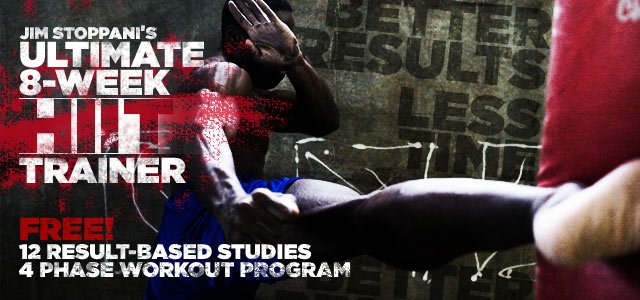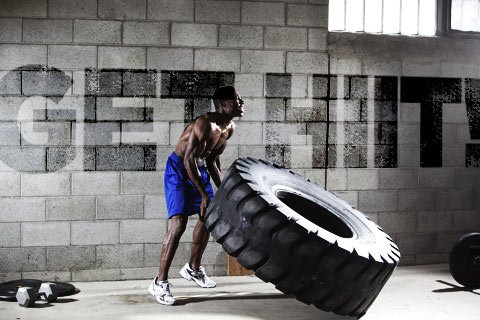Better results in less time. What's not to love about HIIT training?
The Ultimate 8-Week
HIIT-For-Fat-Burning Program
As far as cardio training goes, high-intensity interval training, a.k.a.
HIIT training, has been exactly that among serious fitness enthusiasts-a big hit.
HIIT training has nothing to do with becoming a Mafia assassin, although your body fat may feel like you finally have it in the crosshairs.
This novel form of
cardio intersperses intervals of high-intensity exercise (such as sprinting) with intervals of either low-intensity exercise (such as walking at a slow pace) or complete rest. This style is a departure from continuous steady-state (slow and steady) cardio that most people do at a moderate intensity for 30 to 60 minutes.
With HIIT, you'll be running (or cycling or whatever) like a bat out of hell for brief stretches, but the net effect when all's said and done is better results in less time.
HIIT was developed decades ago by track coaches to better prepare runners. At the time it was known by the oh-so-catchy name of "Fartlek" training, the conjoining of the Swedish words for speed (fart) and play (lek). So it means "speed play," which is a good description of HIIT training.
Growing Body Of Evidence
HIIT has crossed over to the fitness industry due to beneficial results established through both anecdotal reports and published research studies.
In fact, studies comparing HIIT to continuous steady state exercise have shown that HIIT is far superior for fat loss, despite requiring less time to complete.
One of the first studies to discover that HIIT was more effective for fat loss was done in 1994 study by researchers at Laval University (Ste-Foy, Quebec, Canada).
They reported that young men and women who followed a 15-week HIIT program lost significantly more body fat than those following a 20-week continuous steady-state endurance program. This, despite the fact that the steady-state program burned about 15,000 calories more than the HIIT program.
The research has continued along the same lines:
A 2001 study from East Tennessee State University demonstrated similar findings with subjects who followed an 8-week HIIT program (subjects dropped 2 percent in percent body fat) as compared to those who followed a continuous steady-state program (subjects had no percentage drop in body fat) on a treadmill.
A study from Australia reported that females following a 20-minute HIIT program, consisting of 8_second sprints followed by 12 seconds of rest, lost six times more body fat than the group who followed a 40-minute cardio program performed at a constant intensity of 60 percent of their maximum heart rate.
The major reason that HIIT works so well to drop body fat to a greater degree than continuous steady-state cardio appears to be due to the greater increase in resting metabolism following HIIT:
A 1996 study from Baylor College of Medicine (Houston, TX) reported that subjects who followed a HIIT workout on a stationary cycle burned significantly more calories during the 24 hours following the workout than those who cycled at a moderate steady-state intensity.
In a study presented at the 2007 annual meeting of the American College of Sports Medicine by Florida State University (Tallahassee), researchers reported that subjects who performed HIIT burned almost 10 percent more calories during the 24 hours following exercise as compared to those whole performed continuous steady-state exercise, despite the fact that the total calories burned during the workouts were the same.
The 2001 East Tennessee State University study mentioned above also found that subjects following the HIIT program burned almost 100 more calories per day during the 24 hours after exercise.
In addition to the increase in resting metabolism, research confirms that HIIT is effective at enhancing the metabolic machinery in muscle cells that promote fat burning and blunt fat production:
The Laval University study that found a decrease in body fat with HIIT also discovered that the HIIT subjects' muscle fibers had significantly higher markers for fat oxidation (fat burning) than those in the continuous steady-state exercise group.
A study from the Norwegian University of Science and Technology (Trondheim), reported that subjects with metabolic syndrome who followed a 16-week HIIT program had a 100 percent greater decrease in content of the fat-producing enzyme fatty acid synthase as compared to subjects who followed continuous moderate-intensity exercise.
A 2007 study in the Journal of Applied Physiology reported that young females who performed seven HIIT workouts over a two-week period experienced a 30-percent increase in both fat oxidation and levels of muscle enzymes that enhance fat oxidation.
And yet another way that HIIT appears to work has to do with getting the fat to where it will be burned away for good:
A new study published in the American Journal of Physiology sheds some light on another way that HIIT burns more body fat. Researchers reported that 6 weeks of HIIT increased the amount of special proteins in muscle that are responsible for carrying fat into the mitochondria (where fat is burned away for fuel) by up to 50 percent. Having more of these proteins in muscle means that more fat can be burned up for fuel during workouts and when resting.
But Is HIIT A Hit For Bodybuilders?
In a word, yes. While many bodybuilders and trainers argue that going slower and longer with cardio is best to burn fat and protect muscle mass, the opposite appears to be true.
Cardio done at a higher intensity for a shorter period of time will not only help you maintain your muscle, but can actually help you build muscle mass. When you train at a slow and steady pace for a longer period of time, you are training your muscle fibers to be more aerobic and have greater endurance.
Do you know how muscle fibers adapt to becoming more aerobic and gaining greater endurance? By becoming smaller and weaker! The smaller a muscle fiber is, the less time it takes for nutrients to travel within the muscle fiber. This speeds up the rate that the nutrients can be burned for fuel.
But even if you think of this from a common sense perspective, it makes perfect sense. Stating that slow and steady cardio for longer periods of time is best for maintaining muscle mass is similar to saying that curling 5 pound dumbbells for 30 minutes straight will build more muscle than curling 40 pound dumbbells for sets of 10 reps with 2 minutes of rest between sets. See, the higher-intensity workout clearly builds muscle better. If you think about it, weightlifting is actually a form of HIIT!
The research backs this up:
One study in the Journal of the International Society of Sports Nutrition reported that male subjects following a 6-week HIIT program (done for 15 minutes per day at a ratio of 2:1 for exercise-to-rest, 3 days per week) while supplementing with beta-alanine gained over 2 pounds of muscle—despite no weightlifting during the program.
In another study, New Zealand researchers had competitive cyclists complete 4 weeks of HIIT training involving 30-second sprints on a stationary cycle separated by 30 seconds of rest. One group sprinted with high resistance on the pedals, making it harder to pedal, while the other group used a lighter resistance, which was easier to peddle. Both groups peddled as fast as they could during the 30-second sprints. They found that the men peddling at the highest resistance increased their testosterone levels by almost 100 percent, while the group peddling at a lighter resistance only increased test levels by about 60 percent. Since testosterone is critical for boosting muscle size and strength, this means that doing HIIT with greater resistance can aid muscle growth and strength.
HIIT also helps you to maintain your sanity by getting you done with cardio quicker. I can't think of anything more monotonous than being stuck on a treadmill, stairmaster, stationary cycle, or elliptical machine for a good 30 minutes straight!
With HIIT the intensity bursts may be more grueling, but they are short and challenging. That makes the workout more "fun" and makes it over quicker.
Another benefit of HIIT is that you can do it almost anywhere with any piece of equipment—or without any equipment at all! Although it can be, HIIT does not have to be done on gym cardio equipment. The possibilities are virtually limitless. You can use it with a jump rope, with weights, with strength bands, with your body weight.
So consider doing less slow and long workouts in the cardio area and do more HIIT. The benefits will be maximal fat loss due to a ramping up your resting metabolism and fat burning enzymes, while building muscle, all in a minimal amount of time.
The Beginner-To-Advanced 8-Week HIIT Program
The following program can take you from HIIT beginner to HIIT stud in 8 short weeks.
- It starts with a work:rest ratio of 1:4 in Phase 1 for a total workout time of just under 15 minutes.
- Phase 2 bumps up the amount of time in the "work" phase, bringing the ratio up to 1:2 and the total workout time to 17 minutes.
- In Phase 3, the rest ratio is cut in half, bringing the ratio up to 1:1. The total workout time increases to 18.5 minutes.
- Finally, in Phase 4, the rest ratio is cut in half again, raising the ratio to 2:1 and the total time at 20 minutes. This will put you in the advanced ranks for HIIT.
The suggested time of each phase is just that—suggested. If you need to spend more than two weeks at a particular phase before moving up, go for it. Ditto if a phase seems too easy and you want to jump right up to the next phase.
You can do these workouts using tools, such as a jump rope, or simply doing jumping jacks, or sprinting, or working on a stationary cycle. Use your imagination. Just follow the work-to-rest intervals as indicated.
| Time | Activity |
| 15 seconds | High-Intensity Exercise |
| 60 seconds | Rest or Low-Intensity Exercise |
Repeat another 10 times, followed by a final 15-second high-intensity blast.
Total time: 14 minutes
| Time | Activity |
| 30 seconds | High-Intensity Exercise |
| 60 seconds | Rest or Low-Intensity Exercise |
Repeat another 10 times, followed by a final 30-second high-intensity blast.
Total time: 17 minutes
| Time | Activity |
| 30 seconds | High-Intensity Exercise |
| 30 seconds | Rest or Low-Intensity Exercise |
Repeat another 11 times, followed by a final 30-second high-intensity blast.
Total time: 18.5 minutes
| Time | Activity |
| 30 seconds | High-Intensity Exercise |
| 15 seconds | Rest or Low-Intensity Exercise |
Repeat another 25 times, followed by a final 30-second high-intensity blast.
Total time: 20 minutes

 Printable Page
Printable Page PDF Document
PDF Document Printable Page
Printable Page PDF Document
PDF Document Printable Page
Printable Page PDF Document
PDF Document Printable Page
Printable Page PDF Document
PDF Document






ti a destinazione, ci siamo recati a prendere le valigie. ... bvaligia.blogspot.it
ReplyDelete